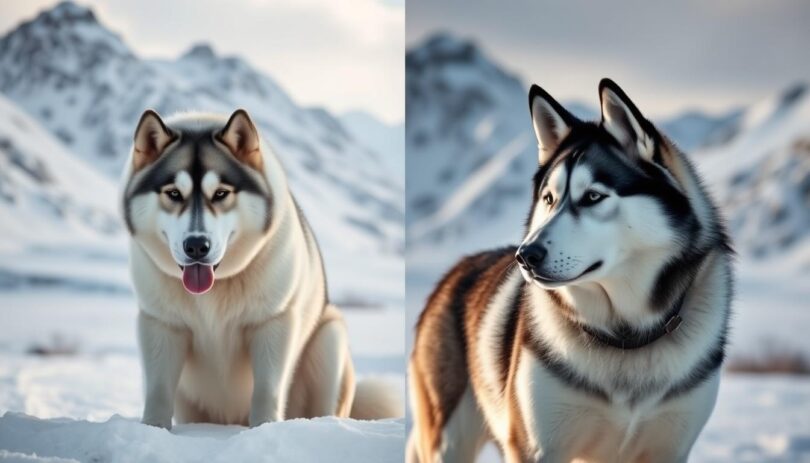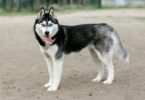What if everything you thought about these two iconic Arctic breeds was only half the story? While their fluffy coats and striking eyes might suggest they’re cut from the same cloth, their histories and purposes reveal a fascinating divide.
Both breeds share roots as sled-pulling powerhouses, but their roles diverged sharply. One was built for endurance across vast frozen landscapes, while the other prioritized speed in relay-style teams. These distinctions shaped everything from their body structures to their problem-solving styles.
Understanding these differences matters more than you might think. Potential owners often underestimate how a breed’s energy levels, grooming needs, and social behaviors impact daily life. Did you know one tends to form tighter bonds with families, while the other thrives in pack environments?
We’ll explore the key traits that set these dogs apart, from their approach to training to their historical timelines. Whether you’re drawn to their wolf-like appearance or working heritage, knowing these details helps ensure the perfect match for your lifestyle.
Understanding the Arctic Origins
Centuries before snowmobiles crisscrossed icy terrains, Arctic communities relied on four-legged partners to thrive. These breeds evolved in isolation, mastering survival techniques that made them irreplaceable. Their shared legacy as sled-pulling experts hides distinct stories shaped by geography and human need.
Roots of the Larger Arctic Companion
One breed traces its lineage to the Mahlemut tribe of Alaska. Developed over 4,000 years ago, these dogs hauled heavy supplies across frozen expanses. Their strength allowed them to pull loaded sleds for miles without tiring. The American Kennel Club notes their build prioritized endurance over speed, making them ideal for long hauls in brutal climates.
Origins of the Speed-Focused Sled Partner
Across the Bering Strait, the Chukchi people bred a lighter, faster counterpart. This breed excelled at rapid transportation, covering shorter distances with agility. Their fame surged during the 1925 Alaska Gold Rush, where teams raced life-saving medicine through blizzards. Today’s Siberian huskies retain that spirited energy, thriving in active households.
Both breeds share a history intertwined with human survival. Yet their roles—endurance versus speed—created lasting differences in temperament and physique. Understanding this past helps explain why one might suit your lifestyle better than the other.
alaskan malamute vs siberian husky: Physical Traits and Appearance
While their fluffy appearances may mirror each other, a closer look reveals striking contrasts in form and function. These differences go beyond aesthetics—they reflect centuries of adaptation to specific Arctic roles.
Size, Build, and Structure Differences
The larger breed stands out with a powerful, broad-chested frame designed for heavy hauling. Males typically weigh 85-100 pounds, while their smaller counterparts range between 35-60 pounds. This weight gap aligns with their historical purposes—one bred for strength, the other for agile movement.
Muscular legs and dense bones give the heavier dogs remarkable pulling power. Their compact structure helps conserve energy during long treks. In contrast, the lighter-built animals feature narrower bodies optimized for speed and endurance.
Coat Types, Colors, and Facial Markings
Both breeds boast double-layered fur, but their coats differ significantly. The stockier dogs have a coarse, woolly undercoat that resists moisture, while sleeker varieties show softer guard hairs. Color patterns vary widely, from solid whites to dramatic black-and-gray combinations.
Facial expressions reveal another key distinction. Almond-shaped brown eyes dominate the larger breed’s face, radiating calm intelligence. Many lighter-built dogs display piercing blue eyes or striking heterochromia—a genetic trait creating mismatched iris colors.
These physical traits aren’t just about looks. Thicker fur provides superior insulation for stationary work, while shorter coats aid heat dissipation during rapid runs. Understanding these features helps owners address grooming needs and climate suitability.
Temperament and Behavioral Dynamics
Understanding canine personalities transforms pet ownership from challenging to rewarding. While both breeds share Arctic roots, their behavioral patterns diverge in ways that shape daily interactions. Let’s explore what makes each uniquely suited to different households.
Distinct Personality Traits
The larger Arctic breed often displays calm confidence and independence. These animals excel at problem-solving but may challenge first-time owners with their stubborn streaks. In contrast, their smaller counterparts radiate playful energy, thriving on social engagement and new experiences.
Experts note one key difference: independence versus cooperation. The reserved nature of the former makes them excellent watchdogs, while the latter’s friendliness suits families seeking an outgoing companion. Both respond best to positive reinforcement during training sessions.
Family Compatibility and Social Behavior
Active families with older children often find the energetic breed a perfect match for hikes or outdoor adventures. Their smaller size and gentle demeanor help them bond quickly with people. The more independent variety tends to form deep connections with a single person but remains loyal to all household members.
When introducing other animals, consider their prey drive. The social breed typically adapts well to multi-pet homes with proper socialization. The stronger-willed type may prefer being the only pet, though early exposure improves compatibility. Both require structured routines to channel their intelligence constructively.
Choosing between these companions depends on your lifestyle. Active households craving constant interaction may lean toward the playful option, while those valuing quiet loyalty might prefer the thoughtful observer. Either way, both breeds enrich family life with their unique charm.
Training, Intelligence, and Sled Dog Heritage
Training strategies for Arctic breeds reveal more than just obedience—they uncover centuries of specialized evolution. These dogs developed distinct learning styles shaped by their roles in extreme environments. Modern owners benefit from understanding how historical demands influence today’s training sessions.
Differences in Trainability and Learning Styles
The larger breed often displays stubborn streaks during repetitive tasks, a trait linked to their history of making independent decisions during long hauls. Trainers often note their need for consistent leadership. Conversely, their lighter counterparts excel at problem-solving but may ignore commands if bored.
Experts suggest varying routines to engage both breeds. Food motivation works well for persistent pullers, while obstacle courses satisfy agile thinkers. A 2022 Canine Cognition Study found one breed completes tasks 23% faster when challenged with new puzzles.
Performance as Working Sled Dogs
Strength versus speed defines their sled-pulling approaches. Heavy-built dogs historically moved 1,500-pound loads over 30-mile distances daily. Their endurance suits freight transportation. Sleeker teams prioritized rapid 10-mile relays, conserving energy through coordinated pacing.
Modern exercise needs mirror these roles. Powerful breeds require 90+ minutes of weighted pulls or hikes. Speed-oriented types thrive with sprint intervals and fetch games. Both need mental stimulation—interactive toys or scent work prevent destructive behaviors.
Understanding these working roots helps owners design effective routines. As one Iditarod trainer notes: “Respect their heritage, and you’ll unlock unmatched focus during training time.”
Selecting the Right Breed for Your Lifestyle
Choosing between these Arctic-born companions requires honest reflection about your daily routine. Their working heritage demands specific environmental and activity conditions to thrive.
Considerations for Active Owners
High-energy owners seeking a workout partner often gravitate toward the husky alaskan malamute. These powerful dogs need 2+ hours of vigorous exercise daily, excelling at hiking or weight-pulling activities. A spacious home with secure fencing proves essential for their roaming instincts.
For those preferring sprint-based activities, the siberian husky alaskan lineage offers better compatibility. Their lighter build suits jogging or agility training but requires mental challenges like puzzle toys. Both breeds demand climate-conscious living—thick-coated varieties struggle in warm regions without cooling solutions.
Urban dwellers should consider noise levels. The husky alaskan group tends to vocalize more frequently, while their counterparts may dig excessively when bored. Matching your schedule to their needs prevents destructive behaviors. Can you commit to year-round outdoor time regardless of weather?
Ultimately, the perfect match balances your activity preferences with their inherited traits. Active households thrive with either breed when prepared for lifelong commitments to exercise and enrichment.
Final Reflections on Your Arctic Companion Choice
Selecting between these legendary northern breeds means embracing their rich histories and distinct personalities. While both share thick coats and wolf-like features, their physical markers reveal unique identities—one flaunts earthy brown eyes and a woolly undercoat, while the other often sports striking multicolored gaze with sleek fur.
Their working heritage shapes modern lifestyles. Heavy-built sled pullers thrive in cooler climates with challenging tasks, while agile runners need space for sprints. Training approaches differ too: independent thinkers require patient guidance, whereas social butterflies excel with interactive play.
Families should weigh energy levels against their daily routines. Active households with time for vigorous exercise will find perfect matches, while quieter homes might struggle to meet their needs. Both breeds demand mental stimulation through puzzles or scent games to channel ancestral instincts.
Ultimately, your choice honors centuries of Arctic partnership. Whether drawn to steadfast loyalty or spirited adventure, these dogs bring generations of resilience into modern life. By matching their traits to your lifestyle, you’ll gain a devoted companion ready to share years of unforgettable moments.










Leave a Comment